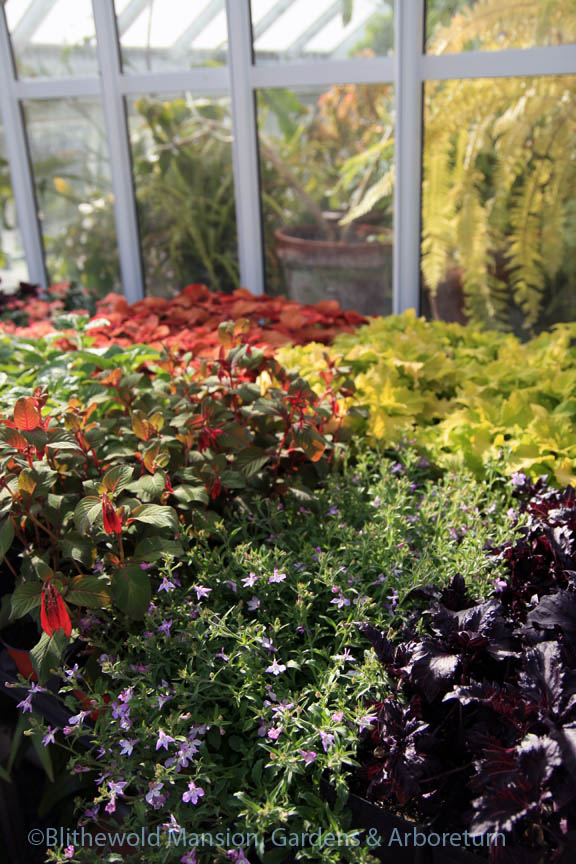Friends don’t let friends plant impatiens
I have bad news and good news. The bad news is there’s a fungus among us. Impatiens downy mildew (Plasmopara obducens), the mysterious ailment that denuded and killed almost every busy Lizzie (Impatiens walleriana) back in July or August of last year, is here to stay. It’s in our soil now and unlike other downy mildews that attack other species of plants, this one is happy to overwinter here in the soil. Add to that, our native woodland wildflower and poison ivy remedy, jewelweed (Impatiens capensis), obligingly harbors it without dying or even becoming particularly disfigured by it.
This coming summer impatiens downy mildew will spread by spores that germinate in humid conditions, just as it did last year. Four hours of standing water (a sprinkler system or a good soaking rain) is all it needs to move from soil to plant where it then becomes airborne. And there is no fungicide that will control it once lesions form on the leaves. Despite that, some growers are determined to keep selling the species that has been their bread and butter ever since petunias fell from favor. But their impatiens will have to be pumped full of expensive systemic fungicide in order to ensure a mere six weeks of immunity in your garden. It’s a heavy price to pay for what has been one of the least expensive and longest blooming bedding plants. Expect that cost to be passed along. Other growers are boldly refusing to propagate an ill-fated best seller and will be offering healthy and more sustainable alternatives instead. And meanwhile, breeders are working to create downy-mildew-resistant impatiens. But don’t hold your breath. They’re still years away.
 The good news is it’s time for a change. Monocultures of impatiens have been planted in industrial parks, corporate and private landscapes, urban and suburban yards for quite long enough. In fact, being planted so exclusively and densely sped their demise, first in the UK back in 2003, then in greenhouses, Florida, up the Eastern Seaboard, and all the way across the more humid portions of the country in the last couple of years. And I, for one, am looking forward to seeing a little more variety in yards, gardens, and landscapes in the years to come. But then, I have never been impatiens’ biggest fan.
The good news is it’s time for a change. Monocultures of impatiens have been planted in industrial parks, corporate and private landscapes, urban and suburban yards for quite long enough. In fact, being planted so exclusively and densely sped their demise, first in the UK back in 2003, then in greenhouses, Florida, up the Eastern Seaboard, and all the way across the more humid portions of the country in the last couple of years. And I, for one, am looking forward to seeing a little more variety in yards, gardens, and landscapes in the years to come. But then, I have never been impatiens’ biggest fan.
I understand that a flat of Impatiens walleriana was wicked cheap to buy. But didn’t those starts need water and fertilizer all summer long? I understand that, if given those things, impatiens bloomed non-stop, and in the shade no less. But did you ever see a bee work the blossoms? And didn’t you get a little bored with them by August? I have never planted them in my own garden and we don’t use them at Blithewold because—and this, really, is the good news—there are so many other gorgeous plants in the world. Some are just as, if not more, colorful; a few might bring out the gardener in non-gardeners; others will be much easier to care for. That’s the truth.
My advice to hardcore impatiens devotees: If you can’t live without them, try them in hanging baskets. And for your garden beds, rather than choosing one alternative stand-in from a long list of shade-loving bedding annuals that includes (and is by no means limited to) New Guinea impatiens (those noisy cousins are immune), begonias, torenia, lobelia, coleus, browallia, oxalis, and nicotiana, plant a kaleidoscope. Variety isn’t just the spice of life, it’s more sustainable. Celebrate all the months of summer — and treat yourself to late season surprises too — by planting tender perennials like spurflower (Plectranthus ciliatus) and fuchsias that bloom into fall and can even be overwintered indoors. And then why not add in a few perennials with fabulous foliage like heuchera, hosta, lady’s mantle, brunnera, pulmonaria, and lamium? Nowadays they don’t cost much more than annuals and, more often than not, live to brighten your beds and borders for years. Please don’t just take my word for it. Ask at your favorite local nursery for suggestions. (No doubt, they will be more sympathetic than I.) And take the good news over the bad.
Apologies to any of you who might have already read this. — It was first published last week by East Bay, RI and South Coast, MA newspapers for my column, Down to Earth.
